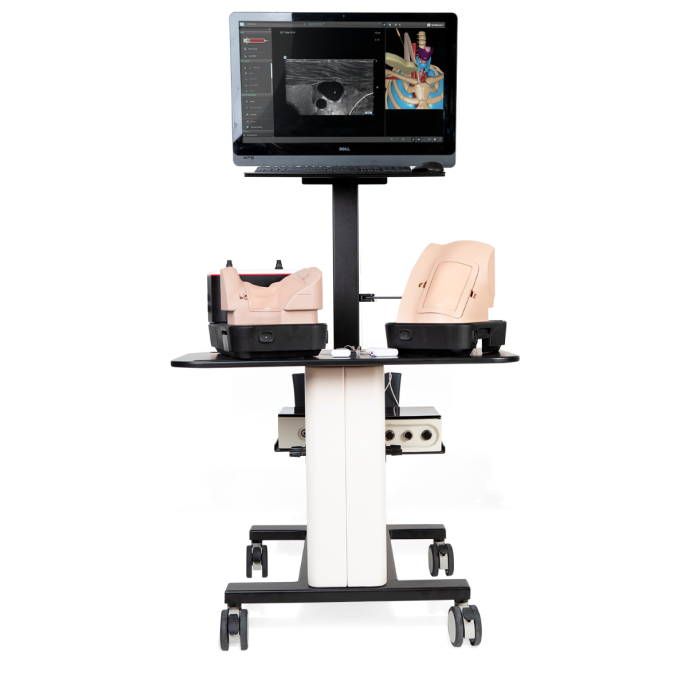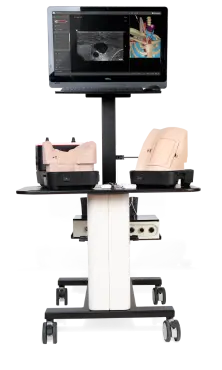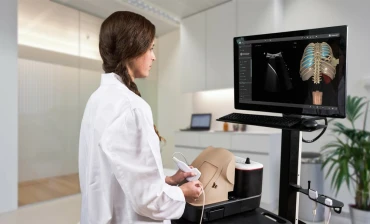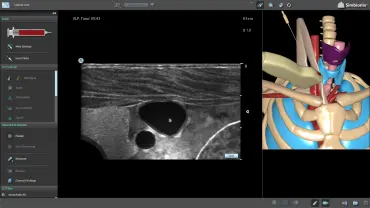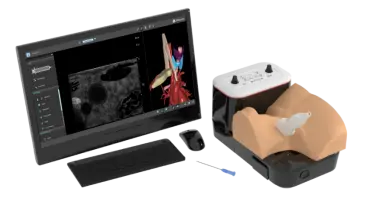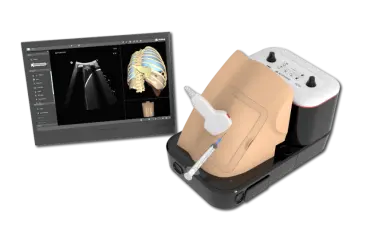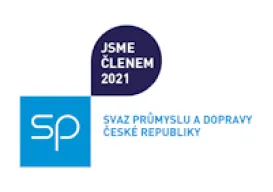PERC Mentor Suite
Since there is often a large demand for the PERC Mentor Suite by multiple departments and programs, the platform was designed not only for a realistic learning experience, but it also offers portability and flexibility with interchangeable components.
The innovative PERC Mentor Suite system is comprised of an anatomical model puncture pad, an ultrasound probe, interventional tools (a needle and a syringe), an innovative all-in-one computer and a multi-touch screen. The configuration is enhanced by a wireless keyboard and a mouse for simple, convenient user operation. The system components are placed on a cart that can be wheeled into another room or department as needed. Height adjustable, this cart makes training comfortable for all learners.
The PERC Mentor Suite’s unique design is ideal for sim centers with limited space as only one system is needed yet many procedures can be practiced. The anatomical model is integrated in a cartridge that can be easily snapped into the system docking station and changed to a different anatomical model when switching modules.
Anatomy Puncture Pad Cartridges
- Thoracentesis Upright Position
- Thoracentesis Supine Position
- Central Line
- Pericardiocentesis
The puncture pad is comprised of several tissue layers and bones, when applicable. The pad is durable and can be utilized for hundreds of needle insertions.
PERC MENTOR SUITE LIBRARY OF MODULES
The PERC Mentor Suite’s ever-growing library of modules, provides training for percutaneous image-guided interventions designed to support hands-on training for multiple specialties. Each module has one or more designated puncture pads that can be easily exchanged, as well as a designated probe and interventional tools (needle, aspiration syringe, wire and more).
The library of modules supports the acquisition and perfection of skills to gain confidence and reach proficiency in a variety of percutaneous intervention techniques and procedures.
CENTRAL LINE PLACEMENT MODULE
The placement of a central venous line is an essential technique in the treatment of many hospitalized patients. The Central Line module incorporates hands-on tasks and clinical cases. This provides procedural understanding, skills acquisition and manual dexterity of ultrasound-guided central venous line placement in the internal jugular vein or the subclavian vein, using in-plane and out-of-plane ultrasound guidance techniques. The simulated procedure is accompanied by comprehensive educational aids.
The module helps gain confidence in central venous line placement steps including ultrasound evaluation, puncture site selection, needle access, wire insertion and verification, in a variety of anatomical settings.
Target Audience
Interventional Radiologists, Anesthesiologists, Vascular Surgeons, Critical Care and Emergency Medicine Physicians.
Module Features:
- First-to-market virtual simulation of ultrasound-guided central line placement.
- Live tracking of both needle and ultrasound probe – view the needle and probe position on both 3D anatomical map and ultrasound image.
- Palpable puncture pad with layers, providing tactile feedback during puncture.
- Procedural tasks provide step-by-step guided intervention.
- Optional – Physical wire introduction provides a realistic training experience.
- Multiple patient anatomies with varying internal jugular vein/common artery diameter and length.
- Simulated complications including arterial puncture.
- Enhanced educational value with self-guided tasks, organ puncture warnings and visual aids such as 3D needle image and syringe filling indicator.
- Enhanced performance report and safety assessment.
THORACENTESIS MODULE
The Thoracentesis Module incorporates hands-on tasks and clinical cases promoting procedural understanding, skill acquisition and manual dexterity of complete ultrasound-guided thoracentesis, including ultrasound evaluation of the pleural effusion, rib palpation, needle insertion and fluid aspiration, for diagnostic as well as therapeutic purposes.
The procedural tasks offer step-by-step guidance of ultrasound-guided needle access. The clinical cases present realistic scenarios with varying sizes, locations and severities of pleural effusion. The trainee can practice cases of both upright position and supine position.
The module enables the practice and progress towards competency in a scaled manner, starting with simpler cases of large effusions before advancing to complex cases such as smaller or lobulated effusions and more. Educational aids assist in optimizing the learning curve, and objective performance assessment is presented upon completion of each task or case.
Module Features:
- First-to-market virtual simulation of ultrasound-guided thoracentesis
- Live tracking of both needle and ultrasound probe – view the needle and probe position on both 3D anatomical map and ultrasound image
- Real-time simulation of fluid aspiration during lung expansion
- In-plane and out-of-plane approach training
- Palpable puncture pad with layers, providing tactile feedback during puncture
- Interchangeable prone and supine position cartridges
- Scaled training from novice to expert with variation in pleural effusion size
- Diversified clinical case scenarios and anatomies such as collapsed/healthy lung, empyema, various diaphragm height, respiratory rate and more, with different optimal puncture site locations(intercostal space).
- Enhanced educational value with self-guided tasks, organ puncture warnings and visual aids such as 3D needle image.
- Enhanced performance report and safety assessment.
PERICARDIOCENTESIS MODULE
Pericardiocentesis is the most common therapeutic intervention for the early management or diagnosis of large, symptomatic pericardial effusion and cardiac tamponade. Echocardiographic guidance has significantly improved the safety and feasibility of pericardiocentesis and has provided the possibility of choosing the best anatomical approach.
This module will include procedural tasks and clinical cases for the training of ultrasound-guided pericardiocentesis, accompanied by comprehensive educational aids. Trainee will be able to choose between common approaches (subxiphoid, apical or parasternal) and practice key procedural steps such as palpation, ultrasound evaluation, needle puncture, wire/catheter insertion and verification as well as fluid aspiration.
Target Audience
Cardiologists, Interventional Cardiologists, Interventional Radiologists, Critical Care and Emergency Medicine physicians.
Module Features:
- First-to-market virtual simulation of ultrasound-guided pericardiocentesis.
- Live tracking of both needle andultrasound probe – view the needle and probe position on both 3D anatomical map and ultrasound image.
- Palpable puncture pad with ribs and cartilage, providing tactile feedback during puncture.
- Self-guided step-by-step procedural tasks for subxiphoid and parasternal approaches
- Anatomical variations of the liver, stomach and pericardial sac
- Variety of optimal puncture site locations
- Real-time simulation of fluid aspiration, heart expansion and volume measurements.
- Clinical variations: small/moderate/large pericardial effusion/tamponade
- Complications such as pneumothorax upon lung puncture
- Enhanced educational value including organ puncture warnings and visual aids such as 3D needle image and syringe filling indicator.
- Enhanced performance report and safety assessment.
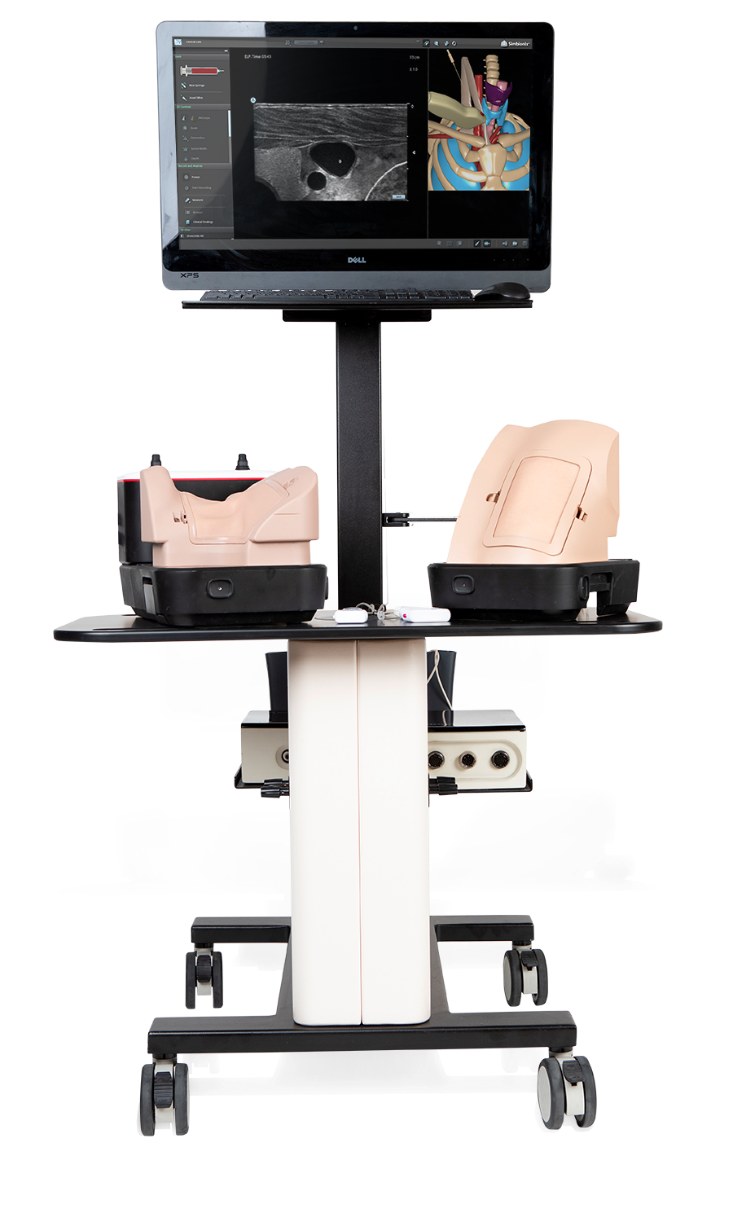
PERC Mentor Suite
